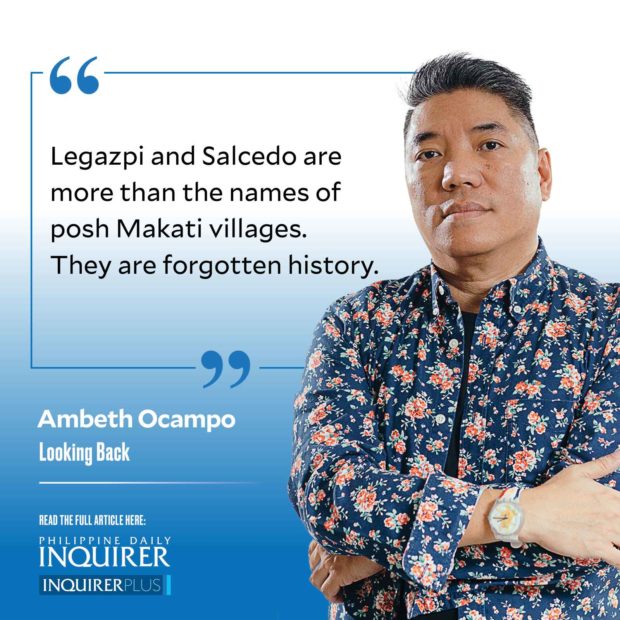
Makati weekend markets held in Salcedo Village on Saturdays and Legazpi Village on Sundays should remind us of Miguel López de Legazpi (1502-1572), first governor-general of the Spanish Philippines, and his grandson Juan de Salcedo (1549-1576). Like bookends, Legazpi is the first conquistador of the Philippines, Salcedo the last. Araling Panlipunan did not tell me that Legazpi carved out a career in Mexico before sailing to the Philippines in 1564, that the “Adelantado” was joined by his son Melchor and his MEXICAN grandsons Felipe and Juan de Salcedo. Two hundred and fifty of the 333 years that our textbooks set out as the Spanish colonial period (1565-1898) should rightfully be seen as the Philippines under Spanish Mexico.
I grew up with a fiercely anti-Spanish history from the elementary to the university level drawn from nationalist historians Teodoro Agoncillo and Renato Constantino, staples from the 1960s, that need to be revisited today. Agoncillo related to me how he deliberately devoted only three short chapters in his landmark textbook history to cover 333 years of Spanish rule, and devoted seven long chapters to the last quarter of the 19th century, from the execution of Gomburza in 1872 to the birth of the nation in 1898. When challenged, Agoncillo asked, “How many chapters do Spanish history books devote to the 800 years under the Moors?” While Agoncillo and Constantino’s history from a Filipino viewpoint remains relevant today as it was in the 1960s, a new generation requires a more nuanced rereading of the Spanish period that goes beyond harping on the ills of colonization to an understanding and empathy of the past. History is not about getting angry for a past we cannot change, but developing an open-minded nationalism in tune with a global and globalizing world.
Acknowledging that Legazpi and Salcedo are part of our forgotten historical relations with Mexico is the first step in reviewing the three C’s in our understanding of the colonial period: conquest, collaboration, and convergence. “Conquistador” carries a bad rap, mainly for Cortes in Mexico and Pizarro in Peru whose conquests were marked by cruelty on the native population. Things were different in the Philippines: While Legazpi and Salcedo did not hesitate to use force on perceived enemies when required, they deployed diplomacy first. Our textbooks highlight resistance to conquest, but downplay collaboration that made it possible.
When Cebuanos resisted Legazpi in 1565, he sailed on and concluded sandugo or blood compacts with Catunao (aka Sikatuna), Sigala of Bohol, and Urrao of Samar. He befriended other chiefs in order to divide and rule. This was also deployed in the conquest of Luzon with Ache (aka Raja Matanda), who was old compared to his young nephew, Soliman (aka Raja Mura) of Maynila (not Maynilad). Across the Pasig was Lakandula of Tondo. Soliman could have successfully resisted the reconnaissance mission led by Martín de Goiti in 1570 and again in 1571, but he got no support from Ache and Lakandula. Soliman seems to have collaborated too, much later. When Legazpi turned up in Maynila, he had a fighting force composed of Spaniards and, take note, a large contingent of Visayans. Thus, conquest was a done deal.
Salcedo is best remembered for establishing a foothold in the Ilocos and for repelling the invasion of Manila by Limahong, pursuing him to Pangasinan, and laying siege to the pirate’s lair till Limahong escaped, never to return, in 1575. Salcedo survived many battles, but died in Vigan, aged 27, from dysentery after drinking dirty water from a ditch.
From Rizal’s anti-Spanish footnotes to Antonio de Morga’s “Sucesos de las islas Filipinas,” we find rare praise for Salcedo as hero: “the Hernan Cortes of the Philippines … the intelligent arm of Legazpi, who through his astuteness, excellent qualities, talents, and personal valor won the sympathy of the Filipinos. He subdued the enemies and inclined them to peace and amity with the Spaniards … he is the only one we know who made the Indios of his encomienda of Vigan the heirs of the greater part of his estate.” Legazpi and Salcedo are more than the names of posh Makati villages. They are forgotten history.
——————
Comments are welcome at aocampo@ateneo.edu

